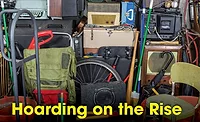The Importance of Universal Precaution in Bio Recovery Work
My introduction to the field of bio recovery was in June of 2002. At the time I was employed at one of the “big box” emergency restoration franchises when the phone rang on what can only be described as a glorious Saturday afternoon, weather-wise. On the other end of the phone was a familiar voice: a repeat customer whose job was to maintain the property at a greater Boston area housing development. Several fires and floods had brought us to this particular property over the years, though, as the caller explained, there was a catastrophe of a different sort this time around.
The description remains vivid. A tenant had an “episode” the previous evening which resulted in the loss of blood and fluids in the bathroom and out into the carpeted hallway.
“Can you guys come and clean it up?” the gentleman inquired.
My reply of course was “Sure, we’ll be there in an hour!”
I had no idea this was a service which existed, let alone one which we offered. I remember thinking that this couldn’t be much different from a mold cleanup. And of course the thought of turning the job down and having the housing authority call the different colored big box truck was at the forefront of my mind as well.
“Great, Steve – thanks, but there’s one more thing I feel the need to tell you,” I recall the property manager saying. “The tenant who had the episode is HIV positive.”
The proverbial light bulb went off over my head. Twelve years and a considerable amount of gore later, that same light bulb goes off each and every time the alarm rings.
Since that memorable initial encounter I have gathered and dispersed information on bloodborne pathogens, trauma scene remediation, crime scene cleanups, regulated medical waste, bio hazard remediation, all which are fashionably being referred to today as “bio recovery.” Along the way I learned of and continue to preach “the gospel of universal precautions.” This is where we treat all blood and fluids which come from another as though they are infectious. I attempt to instill this mantra into the minds our own technicians encountering this work.
We train. We demonstrate. We vaccinate. We provide PPE. We cannot always prepare - at least not for some scenes.
This type of work is not for everyone, as anyone who has ever entered one of these scenes will attest. One simply must question the mental stability of another who actually claims to enjoy remediating the carnage present in certain environments, rewarding as the feeling of restoring one’s property remains to this day. Some learn this lesson through my own “alma matter” – UOTE, or the “University of Trial and Error.” But if bio recovery is the degree one is seeking then UOTE should not even qualify as one’s safety school when filling out those college applications!
After a technician enters a murder scene for instance, particularly one in which children are involved, that technician’s psyche is forever altered.
The past few years have seen many horrific events spawned by inexplicable violence. I recall watching the events of Sandy Hook Elementary School on CNN each night for a couple of weeks while my 6 and 2-year-old daughters slept in their beds on the level above. I wept and I prayed, every night for those two weeks. I prayed for the victims and their families. I prayed for my own family’s safety. I also prayed that we did not get the call to conduct the bio recovery at the school. While I take bio recovery training very seriously, I don’t believe a training program exists which could have prepared anybody for what I imagine that scene to have appeared. We would have gone had we received the call, but we would have been changed.
Extensive training did not prepare me for the scene on Boylston Street in Boston in April 2013. Our company played a significant role in the bio recovery of the most significantly affected areas after the Boston Marathon bombing. It does bring a strange sense of pride that we were able to help the area recover in a visual and sanitary manner, though to say we will never have the need to view our digital photos in order to conjure a visceral recollection of the scene is an understatement of epic proportions. Each of us was affected. We were different when we arrived home late that night than we had been when we left for work early that morning. Not necessarily damaged, but different. Affected. The grief counsellor whom as a company we keep on retainer and each of our technicians had the ability to call and speak of what they witnessed earned his pay that day.
Universal precautions were most definitively applied one year ago on Boylston Street, as they are applied on each and every job we perform. Those universal precautions ensure that our technicians go home to their families at the end of the day. The same universal precautions, however, do not offer any guarantee that when the technician gets home to his or her family that he or she is the same person they were when the sun rose that morning.
Fourteen years after beginning in disaster restoration, and 12 years after that first dalliance with bio recovery, I have witnessed and experienced much change, both personally and professionally. While the changes in our industry during this time have been nearly as dramatic, the rewarding feelings of removing hazards and restoring people’s castles has not diminished. That rewarding feeling is lessened in many bio recovery situations due to the insurmountable loss which often accompanies the job, but in others it is strong. That’s because we can help people recover.
Looking for a reprint of this article?
From high-res PDFs to custom plaques, order your copy today!






